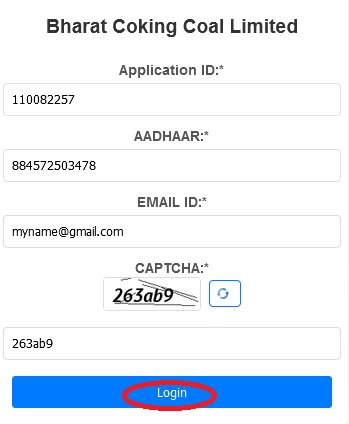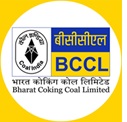BCCL Download Admit Card 2024 Junior Overman : Bharat Coking Coal
Organisation : Bharat Coking Coal Limited (BCCL)
Recruitment Name : Junior Overman 2024
Announcement : Download Admit Card
Date of Exam : 15-09-2024
Website : https://www.bcclweb.in/
How to Download BCCL Junior Overman Admit Card?
Date of Examination is 15th September 2024. To Download Admit Card for the post of Jr. Overman T&S Gr. ‘C’ follow the bellow steps,
Steps :
Step-1 : Go to the link https://bcclweb.in/recruitment/
Step-2 : Enter Application ID
Step-3 : Enter Aadhaar
Step-4 : Enter Email ID
Step-5 : Enter Captcha Code and
Step-6 : Click on “Login” Button.
Related / Similar Admit Card : HAL Download Admit Card 2024 Non Executive Cadre

** “In case of any trouble or unable to download admit card, concerned candidate may mail at recruitments.bccl[AT]gmail.com or contact to Dy. General Manager (P), MP&R, BCCL on +91-7584903853 immediately”.
** The aforesaid link shall be active from 05:00 PM of 21.08.2024 to 12:00 noon of 15.09.2024.
Selection Process of Junior Overman
a. The Selection methodology will comprise of Computer Based Test (CBT) only. No personal interview will be held.
b. Eligible Candidates will be provisionally called for Computer Based Test (CBT) on the basis of their declaration regarding their eligibility such as age, educational/technical qualification, Valid Statutory Certificate etc. as laid down in this notification/advertisement.
c. The CBT will comprise of objective type with multiple choice of answers and there will be no negative marking for wrong answers. The questions will be Bilingual (English/Hindi).
d. The CBT will consist of two sections i.e. “A” & “B”. The Section “A” will comprise question specific to General Awareness/ Aptitude and” will comprise 20 questions of “One” mark each, similarly Section “B” of the test paper will comprise questions relating to Technical knowledge and will comprise 80 questions of “One” mark each, with a total of 100 marks.
e. Exact schedule of CBT will be displayed on BCCL website in due course.
f. Result of the CBT will be available in the official website of BCCL.
g. Qualifying marks (CBT) will be as under:
For OBC(NCL) Candidates – 40 Marks (i.e. 40% of 100)
For SC/ST Candidates – 35 marks (35% of 100)
h. Based on the merit order of marks secured by the candidates in CBT, the shortlisted qualified candidates in the ratio of 1:3 will be called for document verification.
i. In case of a tie of marks obtained in the CBT, it will be resolved on the basis of Date of issue of Competency Certificate by DGMS, and then Date of Birth (elder one being the first) and thereafter Name alphabets.
j. Successful shortlisted candidates, in the order of the total marks scored in the CBT, will be notified to appear for scrutiny of their testimonials through website of BCCL. The candidates shall have to appear along with all original certificates/documents & photocopies thereof as per eligibility criteria notified in this advertisement for scrutiny.

Syllabus of Junior Overman
PART -A : GENERAL ASSESSMENT
Questions – 20
Marks – 20
i. General Knowledge and Current Affairs
ii. Reasoning & Mathematical Ability
PART -B : DOMAIN KNOWLEDGE
Questions – 80
Marks – 80
1) General Safety and Legislation
Duties and responsibilities of workmen, competent persons and officials (excluding managers, assistant managers); discipline amongst workers and control of staff.
Provisions of the Coal Mines Regulations, 2017, relating to Coal mine working; explosives and shotfiring; loading, transportation and dumping; precautions against danger from fire, dust, gas and water and of other provisions and Rules, enforcement of and compliance of provisions under the regulations to which overman is responsible.
Writing of reports required to be made by overman under the regulations. Hazard Identification, risk assessment and risk management, safety management plan. Mine Gases: Generation, Properties and Effects, Detection of Mine Gases, Methanometers and Multi Gas Detectors, Gas Chromotograph, Flame Safety Lamps.
Dangerous occurrences in mines and dealing with the same; accidents, their causes and preventions; accident reports; not disturbing the place of accident. Mine rescue; physiological effect of mine gases; rescue equipment and First Aid. Sanitation and health; ’miners diseases, their symptoms and preventions.
2) Methods of working
Nature of occurrence of coal seams; geological disturbances and their effects on working conditions; dangers and precautionary measures while approaching geological disturbances areas.
The purpose and utility of boreholes in mines; shaft sinking; safety devices; temporary and permanent supports in sinking and working shafts; examination of shafts and outlets. Opencast methods of mining; mechanized and manual methods; deep hole drilling and blasting; shovel and dumpers; dragline; bucket wheel excavators; surface miner; benching; maintenance of haul roads; precautions while extracting developed pillars by opencast method and other safety precautions; methods of reclamation; dump management; high wall mining.
General principles of bord and pillar and longwall method; multi-section workings; methods of depillaring under different conditions; mechanized pillar extraction; precautions to be taken while working near/beneath waterlogged areas; roof convergence and convergence measuring devices etc., stone drifting.
Elements of roof control Rock Mass Rating (RMR) of roof strata; mechanism of roof bolting; support of roadways; face supports and their types, setting, testing and withdrawal; systematic support rules; packing and stowing; protection of surface structures; working beneath statutorily restricted areas and surface structures.
Safe handling and use of explosives in coal and stone; simultaneous short firing; blasting in fire areas in opencast mines; safety precautions. Inspection of workings; inspection and maintenance of haulage and travelling roadways; man riding system and return airways; gates and fences etc.
Suppression and treatment, sampling and analysis of mine dust. Sources of danger from surface water and underground inundation; precaution to prevent inundation and irruption of water; water dams, water danger plans. Gates and fencing, different kind of fences. Reading of statutory plans.

Recent Comments